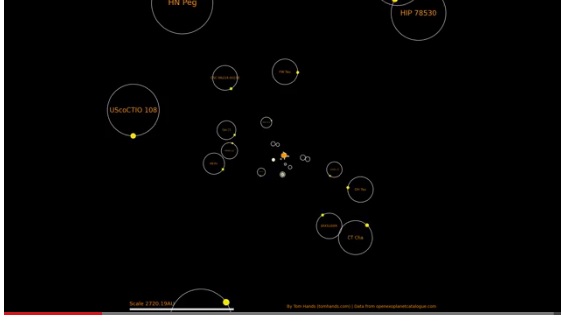6 May 2014
Under normal circumstances most people who dream of staring into space would need to purchase a telescope and a copy of ‘Astronomy for Dummies’ to make sense of it all.
PhD student Tom Hands from the University of Leicester’s Theoretical Astrophysics group in the Department of Physics and Astronomy has made visualising the great beyond a much more manageable process for intrepid space explorers thanks to a novel video that takes viewers on a journey through all the planetary systems we've found so far that orbit a single star.
Using the collected data in the Open Exoplanet Catalogue - which contains information on 1774 different exoplanets in 1081 star systems - Hands produced the video as part of his PhD research.
Exoplanets are planets that exist outside of our solar system and by observing them in the video we are given an insight into just how vast the universe is and how notions of time would differ in other solar systems based on their unique orbits.
Tom said: “I wanted to demonstrate the vast range of different time-scales on which exoplanets orbit their host stars, from things which orbit at many times the separation of the Earth and Sun over many hundreds of years, right down to planets which orbit so close to their star that they complete each orbit in just a few hours.
“I hope to further our understanding of how such systems form through my research. I find it fascinating just how much these exoplanetary systems differ from our own system in scale. I hope people will gain an understanding of the vast differences between systems from the video.”
Tom’s research, which is funded by the Science & Technology Facilities Council (STFC), in particular concentrates on a very specific subset of exoplanetary systems in which 5 or 6 planets are crammed in very close to their stars, each taking just a few days to complete one orbit.
Dr Richard Alexander from the University of Leicester’s Department of Physics and Astronomy, who supervises Tom’s PhD, said: “Tom's research looks into how planetary systems are assembled, by building computer simulations of their formation and evolution. The video shows the scale of the challenge, but also highlights how far we've come. Most of these planets have only been found in the last few years, and Tom is using these new discoveries as tests for his simulations.
“For now we are focusing on one particular type of planetary system, but our long-term goal is to understand how nature produces the enormously diverse range of exoplanet systems shown in the video. Tom’s research will continue to make progress towards this goal.”
The video builds upon research documented in Tom’s ExoVis visualisation, which was the winning entry for the Open Exoplanet Catalogue 2013 visualisation contest.
No longer isolated to the world of science fiction, we are now capable of exploring planets and star systems in greater detail than ever before thanks to the effort of dedicated astronomers and great feats of engineering such as the Kepler Space Telescope. Over time, as technology continues to flourish, more exoplanets will undoubtedly become clearer to us as we gaze out further into the cosmic ether.

Time flies in new exoplanet video exploring beyond the boundaries of our solar system
PhD student Tom Hands from the University of Leicester produces video to demonstrate vast range of time-scales on which exoplanets orbit host stars

Screen shot from the video













